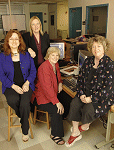THE Journal's 2007 Innovators : 4
Colette Stemple, SusanO'Connor, Amy Scott,and Marion Hanks
Coral Reef Senior High School (FL)
 Some students are naturals at decipheringthe meaning of images and employingthem to evoke responses from viewers—what's known as visual literacy—butmany need to sharpen those skills. Fourteachers at Miami's Coral Reef SeniorHigh School are tackling this challengevia the Incentive Imaging Learning Initiative,a decade-long project built on collaborativeplanning and implementationof technology-supported, cross-curricularprojects using digital imaging.
Some students are naturals at decipheringthe meaning of images and employingthem to evoke responses from viewers—what's known as visual literacy—butmany need to sharpen those skills. Fourteachers at Miami's Coral Reef SeniorHigh School are tackling this challengevia the Incentive Imaging Learning Initiative,a decade-long project built on collaborativeplanning and implementationof technology-supported, cross-curricularprojects using digital imaging.
The collaboration began when thehigh school opened its doors in 1997.Colette Stemple taught Tech Art, andMarion Hanks taught Art and Cinematography.Susan O'Connor's assignmentswere the school yearbook andInformation Technology in the GlobalSociety, while Amy Scott was the Theoryof Knowledge instructor as well asthe faculty adviser and sponsor for thestudent literary magazine, Elysium.Each teacher used various Adobe programs:Photoshop, Illustrator, Page-Maker, Premiere, and InDesign. Inaddition to using the same technologies,the teachers found that they sharedmany of the same International Baccalaureate students.
The foursome decided to team up,sharing curriculum and resources. Theystarted assigning cross-curricular projectsand assisting each other's IB students increating portfolios for their final adjudications.Over time, the team branchedinto other academic disciplines. Forexample, their students conducted a visualexploration of electricity and magnetism.
The Incentive Imaging Learning Initiativeis capturing worldwide attention.The program's students regularly winawards for their work, including honorsfrom the Coca-Cola Art of Harmonycompetition, Adobe's Portraits of Learningcontest, and the Miami Herald'sSilver Knight Awards. Team membersare sharing the projects at conferences,on the Adobe website, and in variouspublications.
"We are learning that digital imagingis not commonly used as an instructionaltool," Stemple says. "However, whenteachers see the success of our students'projects, they are eager to find out howto use this strategy with their students.We are continuing this program in ourclassrooms. We will also continue toshare our ideas and findings with othereducators."
Mike Riley
Bellevue School District (WA)
 One of Mike Riley's top prioritiesafter becoming superintendentof Bellevue SchoolDistrict in Bellevue, WA, in1996 was the development ofa districtwide K-12 curriculum.But Riley is a practicalvisionary. He knew that writingthe curriculum was justthe beginning. Without a wayto disseminate the materialsto every teacher in the district,they would end up gatheringdust. Riley also wantedto enable teachers to capture and share the refinements theymade as they used the lessons; provide better informationabout student assessment; and ultimately make all the instructionalmaterials available toparents and students.
One of Mike Riley's top prioritiesafter becoming superintendentof Bellevue SchoolDistrict in Bellevue, WA, in1996 was the development ofa districtwide K-12 curriculum.But Riley is a practicalvisionary. He knew that writingthe curriculum was justthe beginning. Without a wayto disseminate the materialsto every teacher in the district,they would end up gatheringdust. Riley also wantedto enable teachers to capture and share the refinements theymade as they used the lessons; provide better informationabout student assessment; and ultimately make all the instructionalmaterials available toparents and students.
How to accomplish this? Put the curriculum online.
In 2005, Riley entered Bellevue into a partnership with Microsoft to make a web-based curriculum a reality using Microsoft Content Management Server and Microsoft SharePoint Portal Server 2003. Bellevue Technology Curriculum Manager Eric Ferguson says, "These products were selected because they support multiple authors/editors while presenting the end user with a consistent look and feel—just what was needed to provide seamless access to the curriculum materials."
The Curriculum Web, as the district named it, went online 18 months ago. Staff members have anytime access to curricular resources, including lesson plans and teacher notes, support materials, samples of student work, and online tutorials. In addition, they can post their own comments, modifications, and lesson plans. This fall, those resources, save for exams and scoring rubrics, became available to parents and students. "It's all about transparency," says Dion Yahoudy, who works on district technology asset development. "Now all critical parties have access, not just to a textbook, but to the plans and materials actually used in the classroom."
An additional benefit of the project has been its positive impact on new teachers. "Rather than being required to craft and implement curriculum in isolation," Ferguson says, "new teachers have access to materials published by experienced educators in an environment where collaboration with these experts is also encouraged. Support at this level benefits both teachers and students."
Cathy Barnett
Antwerp Local School District (OH)
Each spring, Cathy Barnett, technology coordinator for AntwerpLocal School District in northwest Ohio, polls the district'steachers in grades 5 to 12. She asks them to identify studentswho are hardworking, reliable, good problem solvers, and potentialleaders. What is she looking for? "New recruits for the followingyear's Student Technology Services program," she says.
Providing adequate technical support is an issue for many school districts—turning to students for assistance is an increasingly common solution. Student Technology Services (STS) was launched in 2001 to serve this purpose. Barnett first developed a Technology Applications course that high schoolers can take for credit, then established a summer boot camp in which high school students provide mentoring and training for budding elementary and middle school student technologists. During the regular school year, STS members operate the district's help desk and provide technical support in the form of repairs and installation of equipment and software. But Barnett says their responsibilities go beyond that.
"These students help provide formal staff training in new software and hardware," she says. "They are included in discussions related to district technology initiatives and help make decisions about the course the district will take."
In addition, STS membership requires that students participate in a service learning project funded by a Learn and Serve grant from the Ohio Department of Education. The project consists of producing training DVDs for local community agencies and industries and facilitating a "Seniors on the Web" computer class. The DVDs, which cover topics such as Microsoft Word basics and internet basics, are used in class and made available to those unable to attend.
The success of STS is spreading as other tech coordinators model their programs after Barnett's. And she couldn't be happier. "Since STS began operation, district staff members have increased their technology usage and literacy by 80 percent," she says. "In addition, STS members show increases in leadership and problem-solving skills as a result of their participation. Higher levels of self-motivation and confidence among these students are also by-products of the program. The STS students are well respected and appreciated by everyone in our community."